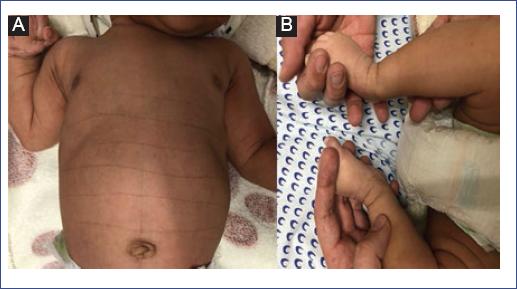Introduction
Pigmentary or vascular abnormalities can cause transient skin color changes in the newborn. Pigmentary anomalies can be related to melanin pigment with dermal melanosis (Mongolian spots) and transient epidermal hyperpigmentation, being typical examples of melanin-related abnormal pigmentation1. In the newborn, transient hyperpigmentation can be found in genital areas, lower abdomen, areolae, axillae, pinnae, and in the base of the fingernails, most probably due to in utero hormonal influence (melanocyte-stimulating hormone [MSH]). However, non-hormonal hyperpigmentation patterns can also occur, such as the horizontal bands of hyperpigmentation in the abdomen or back, which are temporary and of unknown etiology1. To date, only a few reports have described this anomaly known as transient pigmentary lines of the newborn2-8.
Microphthalmia/anophthalmia/coloboma (MAC) constitutes the spectrum that results in uni or bilateral malformations of the eye due to failure of the primary optic vesicle, reduction of the axial length of the ocular globe, or failure of the closure of the optic fissure, respectively. MAC has a prevalence of 2 in 10,000 in the population and may be sporadic or familial, isolated, or part of a syndromic disease9. In this report, a male newborn, exhibiting the unusual combination of transient infantile patterned hyperpigmentation and ocular malformations, is described. To the best of our knowledge, this entity has not been previously described in the literature. The sequencing of SRY-box 2 (SOX2) and Melanocyte-inducing transcription factor (MITF) genes was conducted to investigate a possible monogenic origin of anophthalmia. The first gene was analyzed because it is the most common etiology of monogenetic anophthalmia. In contrast, the other gene was studied because it is implicated in ocular malformations, such as anophthalmia, and congenital anomalies of pigmentation.
Case report
A 1-month-old male was referred to the Genetics Department due to linear dermatologic hyperpigmentary abnormalities and ocular malformations. He was the only child of young, non-consanguineous, healthy parents. His family history was uneventful, and his mother reported no exposure to potential teratogenic agents. He was born by abdominal delivery, with a weight of 3800 g (percentile 50) and 52 cm (percentile 75) of height. Other somatometric newborn measures were unknown. On examination, multiple dark, horizontal, and pigmentary lines were observed, initiating in the thorax under the nipples and extending to the pelvic region. Seven distinct dark horizontal pigmentary lines were observed, which were divided by perpendicular dark lines located from the thorax to the pelvis (Figure 1A). Additional dark parallel linear pigmentary lesions were detected in the thoracic and pelvic limbs (Figure 1B). Right anophthalmia was found and confirmed by ocular echography. The left eye was normal. Unfortunately, subsequent clinical assessments were not possible. After obtaining the parental informed consent, a blood sample was drawn from the patient. The polymerase chain reaction amplification was performed, followed by the Sanger sequencing of the complete coding sequences of SOX2 and MIFT genes. No mutations were identified. A biopsy of the pigmentary lesion was not allowed by the parents.
Discussion
At present, the etiology of transient patterned hyperpigmentation is unknown. It has been hypothesized that it may be caused by the stimulation of the MSH in utero, a mechanical trauma from hyperkeratosis due to a fetal posture of flexion in utero that leads to post-inflammatory hyperpigmentation, or due to abnormalities of skin exfoliation as a consequence of fetal flexion4,5,7.
Only eight patients with transient lines of hyperpigmentation have been reported, including the present case. This uncommon disease was first characterized in 1967, with lines persisting for 4 months2. Although most cases are isolated, other associated anomalies have been reported, such as ichthyosis vulgaris, ventral hernia2, and multiple macular hyperpigmentation on the back and over the spinal column4.
In this patient, unilateral anophthalmia was also observed, which raised the possibility of a common origin for both skin and ocular anomalies, although both abnormalities may also be isolated entities. To rule out a Mendelian origin of both congenital defects, a molecular analysis of SOX2 was performed, because this gene is the common cause of the Mendelian MAC spectrum9. SOX2 may induce the proliferation of epithelial and connective tissue cells10. Furthermore, our group reported the association of anophthalmia with dental abnormalities originated from epidermal tissue. Furthermore, the MIFT gene was analyzed since it encodes a central protein for the development of neural crest-derived melanocytes and optic cup-derived tissues10. MITF mutations are a well-established cause of the Waardenburg syndrome type 2A, a disease exhibiting both ocular and melanogenesis defects. However, no mutations in either SOX2 or MITF genes were identified.
To the best of our knowledge, this patient is the eighth case reported in the literature with transient patterned hyperpigmentation, and the first one associated with anophthalmia. A monogenetic cause for this uncommon association could not be demonstrated after the molecular analysis of SOX2 and MITF genes. Both entities may be isolated; however, a genetic origin or even a low proportion of somatic mosaicism cannot be ruled out as the etiology of the disorder.











 nova página do texto(beta)
nova página do texto(beta)



